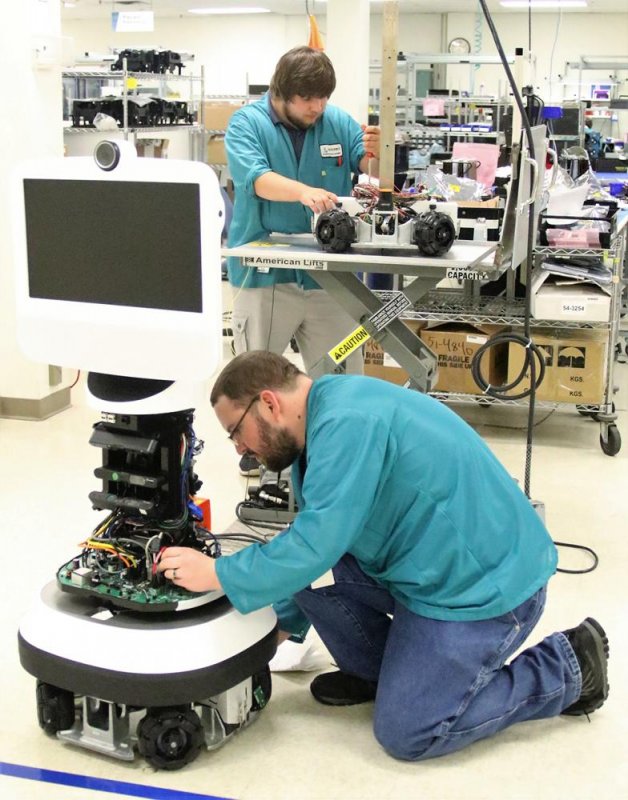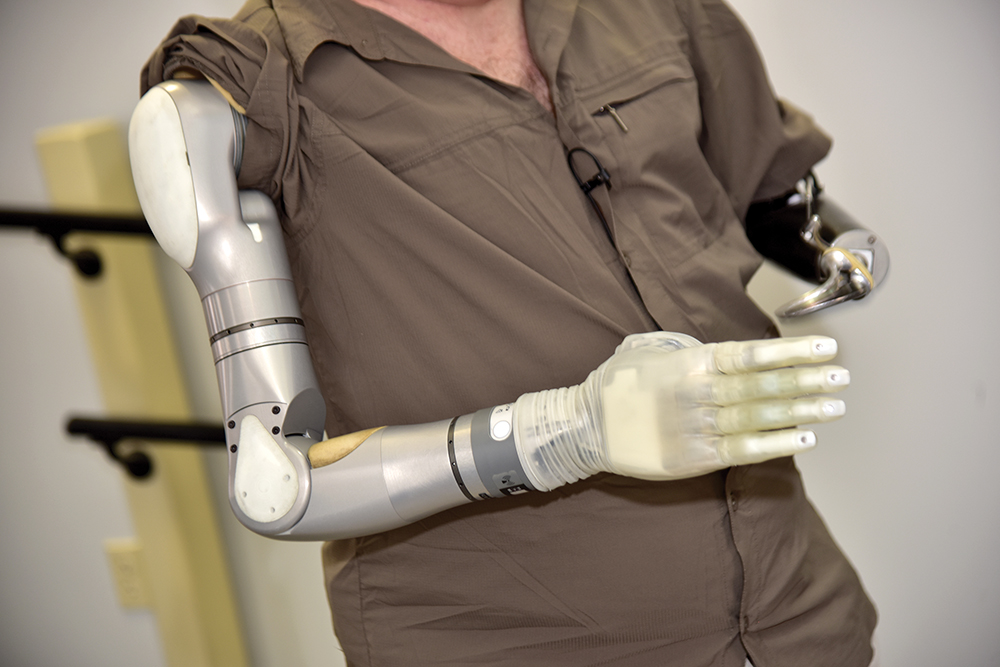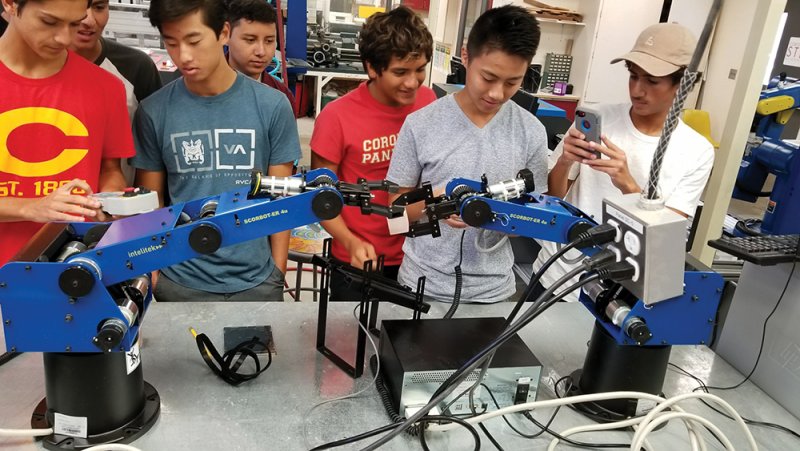
Jason Walker, third from left, and the team with their robots at Waypoint Robotics in Merrimack. Courtesy photo.
Jason Walker stands off to the side of the semi-quiet of his factory floor. The room is loaded with shelves arranged for efficiency and neatly stacked with metal parts and rubber bits. Walker noodles on what looks like a tablet strapped to a video game controller; within minutes, the robot at his feet whirs to life, gliding sideways and diagonally, avoiding obstacles.
Walker, CEO and cofounder of Waypoint Robotics in Merrimack, explains once a month he tests its products’ ease of use. “We box up the whole robot and try to pretend that we’re the customer,” he says. “And then I get to come back and see if I can break it.”
In actuality he doesn’t break it. Waypoint’s omnidirectional autonomous robots regularly go from crate to navigation in about 15 minutes. “And that’s absolutely unheard of,” he says. “There isn’t even a robot toy that you can do that with. …We try to make it as easy as possible.”
The ease is built into the design, he says. The robot’s controller—a tablet attached to a game pad—is meant to be familiar to the average user. Even the robot’s guts have been streamlined to the point at which no one is worrying whether one small component will fail and doom the entire robot. “The customer that we’re going after are small to midsize manufacturers,” he says. “Because we’ve built a product that for the first time is easy enough for anybody to drop into any situation, you don’t have to rebuild your factory or retrain all your people, you know? You drop this thing in and it’s so easy to understand that people get it.”
Walker has touched on the key to the robotics industry boom over the past few years. It used to be that it was cost prohibitive for businesses to automate. Robots were expensive and complicated, and it took time and money to find or train labor skilled enough to use and fix them. But not anymore. Robots—whether used to move products on a factory floor, help ailing students telecommute to school, or autonomously vacuum a rug—have become simpler and cheaper, which has been a boon to the industry.
A Small Local Industry
While NH is hardly a major player in the robotics industry, it has seen its share of success stories. Among the first robotics companies in NH to take off was MobileRobots Inc., which launched in 1995. Located in Amherst, MobileRobots designed and manufactured robots, autonomous navigation systems, and software.
As the company grew, it attracted the attention of California-based Adept Technology, which acquired MobileRobots in 2010. OMRON Corporation, based in Japan, acquired Adept in 2015. OMRON Adept Technologies did not return calls requesting an interview, but the Twitter feed for MobileRobots, its research and academic division, announced MobileRobots closed in January. The voicemail system at the Amherst location states the NH site is the company’s East Coast product and demo center.
VGo Robots, founded in 2007 in Nashua, develops robots that are controlled remotely by a PC, Mac or iPad and have a screen showing the face of the person controlling it to “create a more interactive and mobile videoconferencing experience,” according to its website. The company gained traction and was acquired by Vecna Technologies in 2015, which relocated the company to Cambridge, Mass.
Now Waypoint Robotics has stepped to the fore as the next up-and-coming robotics company in NH. It is not the only NH company hoping to make its mark in the industry. GMRobot Inc., a startup in Bedford, is focused on robotic and motion control products but has failed to find solid footing since it launched five years ago, says President Yawei Yang. He says that while the company has changed its focus several times, he now has two new partners dedicated to moving the company forward.

Yawei Yang, president of GMRobot Inc. Photo by Matthew J. Mowry.
Yang says GMRobot is now focused on building robots for the packaging industry and is moving in September to Salem where it has leased a 30,000-square-foot warehouse space. He says the move puts the company closer to Boston and the talent it will need when it begins hiring. GMRobot plans to purchase robotics parts from China and assemble them here, as well as develop the software and motion control in the United States. Yang says the partners are still developing their technology and are in the process of building a prototype.
Cirtronics Corporation, a contract manufacturer in Milford that specializes in electromechanical systems and printed circuit board assembly, has found a growing market in the robotics industry. Its foray into that industry began in 2014 when a robotics company approached them for contract manufacturing.
“As we worked with our first few customers from the robotics industry, we refined the knowledge and skills to become uniquely qualified to partner with robotics companies, and that has really been a successful strategy,” says Stephanie Gronvall, director of marketing for Cirtronics. The company now manufactures robots for several robotics companies and is in conversations with others.

Cirtronics employees work on robots for Ava Robotics. Courtesy photo.
“We already have a significant presence in the local robotics manufacturing market, and we expect robotics of all forms to continue to be a growing percentage of our business,” Gronvall says. Among its customers is Ava Robotics in Cambridge, Mass., which has its Ava telepresence robot built and tested at Cirtronics. “The robots we manufacture are used in a wide range of applications, including military and defense, first responder support, virtual presence, medical and surgical, warehouse automation, and other specialized applications,” she says.
But the most influential person in NH’s robotics industry is inventor Dean Kamen and his company, DEKA Research & Development Corp. While robotics is not the focus of the company, there is no mistaking that its innovative technology impacts the industry. DEKA employs 400 professionals and is known for the Segway, the self-balancing personal transporter. Segway, located in Bedford, was acquired in 2015 by Ninebot Inc., a Beijing-based transportation robotics startup. Ninebot is creating robots for personal and commercial use, such as food deliveries, in addition to transporters.
In 2016, DEKA announced it was partnering with Toyota Motor North America to develop the next generation of DEKA’s iBOT, a motorized wheelchair that allows the user to “walk” up and down stairs and rise from a sitting to a standing position.
DEKA also developed the technology behind the LUKE arm prosthesis—in essence, a robotic arm—with $40 million in funding from the Defense Advanced Research Projects Agency to benefit veterans with amputations. The LUKE prosthetic arm uses sensors to decode natural muscle signals, essentially translating the amputee’s thoughts into movement. The LUKE arm’s wrist motion combines deviation with flexion and extension, a feature no other prosthetic arm has, to allow it to smoothly change positions when picking up items. Mobius Bionics, a new medical device company in Manchester focused on bringing advanced prosthetic technologies to the commercial market, is manufacturing the LUKE arm.

The LUKE arm is among the innovations to come out of DEKA. Courtesy of Next Step Bionics and Prosthetics.
Yet the biggest influence of Kamen and his company on the robotics industry is the establishment of FIRST (For Inspiration and Recognition of Science and Technology), a program based in Manchester.
FIRST aims to engage children across the world from kindergarten to high school in mentor-based, research and robotics competitions to inspire them to enter STEM fields (science, technology, engineering, and math).
In April, the FIRST championship had more than 30,000 students from 74 countries participate, and they were supported by more than 6,000 coaches and mentors as well as 2,400 volunteers. (See sidebar on page 97.)
Major International Market
The Robotic Industries Association, the industry’s trade group, estimates that there are now 250,000 robots in use in the U.S., the third highest level in the world behind Japan and China. The Association reports that a record number of robots were shipped to North American companies in the first quarter of 2018, causing both units shipped and shipment revenue to achieve record levels. The Association also states that 10,730 robots valued at $507 million shipped to North American customers in the opening quarter of the year, representing a growth of 22 percent in units and 3 percent in dollars over the same period in 2017. And that’s significant since 2017 was a record year for the industry.
Further, while automotive companies have been automating for years, the numbers show that other industries are coming to the party. According to the Association, industries experiencing the most growth in units shipped so far this year are life sciences (262 percent), plastics/rubber (130 percent) and food/consumer goods (64 percent). “In the past when the automotive market retracted, the entire robotics industry would decrease along with it,” states Jeff Burnstein, president of the Robotic Industries Association, in a press release earlier this year. “The fact that we’re seeing significant growth in non-automotive industries bodes well for the robotics industry as a whole. The automation industry continues to grow robustly as companies invest to increase productivity and quality while boosting competitiveness and also providing opportunities for workers.”
And because the robotics industry is so diverse, ecosystems of specialized businesses, each responsible for a component—such as R&D, design, manufacturing or programming—tend to crop up around it.
These ecosystems tend to form around a core of educational institutions, as is the case in Massachusetts. There are dozens of robotics companies in the Boston area, and Walker says it’s one of the largest markets in the country for robotics companies. With that comes a robust robotics community, culture and tribal knowledge, he says. But Walker says some of those professionals don’t want to put up with the commute to Boston and may instead consider working in NH.
Cirtronics is positioning itself to help grow the state’s robotics industry with the proposition that companies can focus on developing the technology and tap into Cirtronics’s manufacturing expertise, says Andy McMillan, acting chief marketing officer and chairman of the board of advisors at Cirtronics.
He also points out that there are many software companies in the state that can also assist a growing robotics company.
Walker of Waypoint says NH is well positioned to support the industry, as there are numerous vendors and manufacturers in the state. “There’s a whole lot of this robot that we can have made locally,” Walker says, pointing to his robot. “I’m a big believer in supporting your local economy. The fact that we’re able to use local vendors is great.”
Along with that, he says, comes a workforce full of manufacturing engineers and technicians as well as training programs.
NH Advantage
New Hampshire has a long history of R&D and tech industry presence, says Sridhar Raghavan, NH chairman of the Robotics and Automation Society of NH, an affiliate of the Institute of Electrical and Electronics Engineers (IEEE). Raghavan says there are several reasons for this, including the state’s tax-free status, startup-friendly atmosphere, existing tech talent that runs the gamut from entry-level to expert (particularly in southern NH), and government that champions the tech sector and efforts to improve it.
Employers and the state continue to highlight the quality of life NH offers. “You can do robotics from anywhere…. And the kinds of people who can [perform] robotic design and some of the robotic system components are able to live wherever they want and do their work,” McMillan says.
Raghavan says that to accelerate the growth of the industry in the state, there needs to be critical mass, including the addition of a few strong high-tech manufacturing companies, particularly automotive; the addition of one or more national research labs in new and emerging fields; and a major catalytic event, such as a move to the area by Amazon, Google, Tesla or NVDIA.
The Education Divide
Raghavan also says that the state needs more “incubation belts” around its universities and colleges, particularly Dartmouth College and the University of NH (UNH). Walker agrees, saying that is an area where Massachusetts has the advantage.
For instance, the Massachusetts robotics community is deeply tied to universities that specialize in tech and robotics interest groups, Walker says, offering connections—and possible advantages—that are harder to make from NH. “Being in Boston, you have that huge advantage,” Walker says. “There are great universities here in New Hampshire, but it’s not like [Worcester Polytechnic Institute] where there is a major and a master’s program in robotics. It’s not MIT or Wentworth or Tufts.”
New Hampshire's colleges and universities do have some robotics offerings. Southern NH University offers an online Bachelor of Science in Information Technologies with a concentration in Robotics and Artificial Intelligence; Plymouth State University offers a Bachelor of Science degree in electromechanical technology and robotics; Manchester Community College offers an advanced manufacturing technology program with robotics as one of three focus pathways; and UNH and Dartmouth College offer a variety of classes and programs geared toward robotics.
Walker says leaders in NH’s tech world are all trying to build this ecosystem. The more they do that, he says, the more, they hope, universities will in turn build curriculum that attracts students who want to pursue robotics.
There is a disconnect between education that exists and what employers in high-tech industries need from recent grads, says Frank Grossman, director of FIRST NH (the state chapter of FIRST), yet there is reason to believe this is changing. “What I have been seeing lately is a closer relationship between businesses and universities,” Grossman says. “I think that the technical skills that have been needed from the universities have not been there. But I think the universities have really woken up to that, on how they solve that.”
Grossman says colleges and universities are figuring out how to be not just four-year educational institutions but long-term training facilities. “Things happen pretty fast now, and I think they realize that you’re going to have to be retrained a few times,” Grossman says.
Ido Yerushalmi, CEO and president of Intelitek, a Derry-based firm that designs high-tech educational and training programs for middle schools, high schools, universities and technical training centers, has noticed this change and says Intelitek has seen an increase in demand for its products. This is a direct result, he says, of the market already needing a workforce with different qualifications than what is currently being offered.

Students at Intelitek in Derry. Courtesy photo.
“There are continuous changes in the way that industry works, and industry is becoming more and more automated,” says Yerushalmi. “If you look at the restaurant business, you look at agriculture, manufacturing—all of them are undergoing different types of moves into automation where either robots or just automatic processes are taking over some jobs. This means that there have to be people in these organizations who know how to set these things up, know how to tweak them, how to fix them and maintain them.”
Additionally, workers need to know how to communicate with the machines as well as analyze and collect data. “It creates a whole different set of skills that are in need,” Yerushalmi says.
Cirtronics’s McMillan adds that equally important to having the right training available is letting the next generation—as well as current workers who need retraining—know that there is more to being a part of the robotics industry than just designing robots. While Cirtronics doesn’t do any robot design, robotics is still a prime component of the company's business. Jessica Kinsey, career development manager at Cirtronics, says, “Though we don’t design robots here at Cirtronics, we do work in partnership with our customers who are the designers and then prepare them for manufacture.”
Which is why, McMillan points out, that within the scope of robotics, a person could make a career in manufacturing and engineering, quality assurance, and testing and test design among other jobs.
“All of that is part of the ecosystem that makes robotics real and relevant,” he says. “When you talk about getting students intrigued and interested in robotics, the scope of that is bigger than just the design. And I think that’s important because I think there are plenty of students for whom robot design is not the right thing, but other parts of the ecosystem certainly are.”
Grossman agrees that students not looking into robotics as a career will still likely need to have some working knowledge of automation.
For example, Grossman says, when he tours schools in northern NH, he encounters people who don’t see the need to start a FIRST robotics team because those industries aren’t located in that part of the state and so the skills don’t seem as relevant.
But he points out that even smaller manufacturing companies are automating, and students need to be educated in, at the very least, how to work with automation. He also points out to them that local industries like maple sugaring may be automated because that will give that local producer the advantage. “Students who don’t know about automation might not be able to compete,” Grossman says.
He says he’s fond of quoting Kamen that FIRST is not about using kids to build robots, but using robots to build kids. Kamen says FIRST helps science and technology compete for the attention and hearts of students, which is why it is designed to be a team sport.
“You never see a kid running around a sport saying, ‘I want to be second,’ but they would take a math course pass fail,” he says. Kamen adds like any sport, FIRST teaches kids about teamwork, but unlike sports, turning pro is far from out of reach. “In our sport, every kid can turn pro,” Kamen says.

 Current Issue - April 2024
Current Issue - April 2024